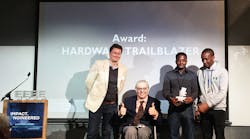For engineers, crowdfunding a hardware idea is difficult because pure capital alone is not enough. To create a truly innovative product that not only works, is scalable, profitable, and has a positive impact on society requires testing, design iteration, customer feedback, and design guidance from industry experts.
The American Society of Mechanical Engineers looks to help the “starving” engineers by guiding and shaping their technology ideas through the Innovation Showcase (IShow) competition. The competition’s purpose is to help highlight products that will bring to market a social impact. ASME describes the goal of IShow as “hardware-led social innovation,” which is taking a physical product to market to solve a social or environmental problem by utilizing a sustainable business model. Since 2015, IShow has discovered several young engineering entrepreneurs around the globe and helped cultivate their design ideas.
Anyone within the United States can apply to the competition. There are also competitions held in Kenya and India. Applicants must have an existing prototype and be interested in receiving financing, technical support, and access to industry networks that will assist in taking the products to market. Thirty finalists pitch to ASME-selected judges in person and receive product exposure, advice, and technical insights. Nine of the innovators will win a share of $500,000 in prizes including an extensive design and engineering review by a panel of experts. The competition is curated into eight themes:
- Water and sanitation
- Energy
- Environment
- Food and agriculture
- Economic development
- Community empowerment
- Safety
- Education
For their applicants, ASME makes available its Inventor’s Guide. The guide helps design engineers with their products by breaking down the design process into four categories.
- Customer/User Knowledge
Customers and users must drive the design and development of hardware. Solutions should be user-centric and delivered at a competitive price point. The engineer should focus their design on who will buy and use your hardware, how they will purchase it, and factor in their environmental/financial cues. - Hardware Validation & Development
Ideating, prototyping, developing, testing, and validating hardware requires a structured process that encourages and ensures feedback and iteration. In the guide, engineers will find tools, techniques, and questions on how to refine, scrutinize, and—most importantly—iterate their hardware. - Manufacturing Optimization
This part of the guide stresses the importance of tooling, supply chains, maintenance, and cost. Considering how a designer will build their product is an important of the process and should begin early. - Implementation Strategy
Hardware only has an impact if it is consistent, scalable, and sustainable. Establishing a business model and scaling strategy requires market and customer knowledge, testing, and user feedback.
The nine winners of the 2017 IShow competition were presented at the Impact.Engineered Day hosted by ASME. For those interested in submitting their ideas for the 2018 IShow compeititon, applications are open now. Click here for more information. Check out the gallery below to see the nine winners of the 2017 IShow and the winner of the Hardware Trailblazer award.
SWACHH
SWACHH (Saral Design Solutions Private Limited) is India’s first indigenous designed automatic machine that makes ultra-thin sanitary napkins.
BrailleMe
With BrailleMe, the visually impaired can access any digital information instantaneously in their own tactile script Braille at a price 10 times lower than existing products.
Saans
Saans is a multi-powered, low-skill, neonatal breathing-support device that maintains respiration and oxygenation in neonates with Respiratory Distress Syndrome in resource-constrained settings.
Matibabu
This non-invasive device used to test for malaria uses custom-made hardware that is connected to a smartphone to aid easy diagnosis within households.
Science Set
This affordable, portable, practical, and highly scalable science lab can fit in the book bags and on the desks of students.
Sign-io
A sign-language-to-speech-translation glove has been developed to address the language barrier between sign-language users and the general public.
Biolite Homestove
This ultra-clean cookstove reduces smoke emissions by 90% and biomass fuel consumption by 50% compared to traditional open-fire cooking, while also co-generating electricity from the flame to charge mobile phones and lights.
QuickSee
PlenOptika developed the QuickSee to disrupt the barriers to eyeglass prescriptions for billions of people worldwide so that they can get the eyeglasses they need.
EV 8 Cooler
Evaptainers are low-cost mobile refrigerators that run on water. These are perfect for low-income families who live off-grid or cannot afford a conventional refrigerator.
Winner of the Hardware Trailblazer Award Goes To...
As voted on by the attendees of ASME’s Impact.Engineered Day, the Hardware Trailblazer award was given to Sign-io for its sign-language-translating gloves.











